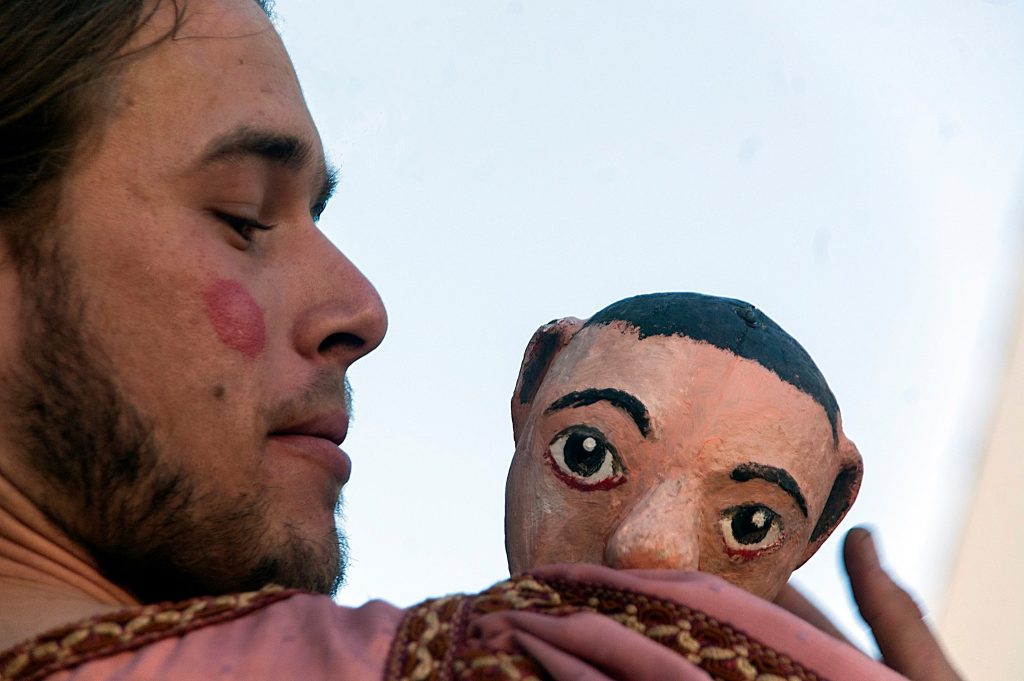Two Carnival “dames” (matrafonas) on stilts literally manipulate the male characters portrayed by marionettes

Poster by Diogo Vaz Cavaleiro,
inspired by 16th-century woodcuts
In this first Portuguese farce, from 1509, justly reccommended for reading in the 9th grade, Gil Vicente satyrises the upturning of traditional mores and the dearth of able men caused by the mirage of quick riches in the Orient. Being a playwright, Vicente does not write an essay; he creates a situation. He portrays a young woman left by her husband with ample supplies and free rein for the three years of his return voyage to India. Smart and hot-blooded, she coerces her house maid to help her manoeuvre several lovers. When her husband returns from an arduous, profitless voyage, she plays him with the same adroitness. For Gil Vicente, a traditionalist, this woman in dominant position epitomises the new “upside down world”. Ironically, he names her Constance.
On the other hand, the successive decrees on apparel, attempting to restrain the epoch’s ruinous taste for luxury and ostentation – a frequent target of Vicentine satyre – in fact regulated and defined, down to fabrics and colours, what each one could wear in conformity with their social station, profession, sex, etc. The habit made the monk!
These aspects were the foundations of our dramaturgy, which combines a faithful reading of the text with diverse manipulation techniques – from glove puppets to Sicilian-style puppets – as well as other elements that since then became rooted in the country’s tradition, such as gigantones (giant processional puppets), matrafonas (Carnival “dames”), and the Portuguese guitar, recovering a dusted-off, bold, earthy Vicentine style that may engage and amuse students, erudites and the general public. Premiered in April 2018, it has been presented at Palácio Nacional de Sintra, at Festival Marionetas na Cidade in Alcobaça, at the Museu do Circo in Lousã, in Teatro da Comuna, in AvanTeatro-Festa do Avante, at Lisbon’s Palácio da Independência, and several festivals, including the prestigious BIME- Évora International Marionette Bienale. The national TV network RTP África dedicated a 30 min documentary to our work, focusing on this play.
José Henrique Neto

TEAM
Dramaturgy and Direction: José Henrique Neto
Puppet Construction and Poster: Diogo Vaz Cavaleiro
Original Music: João Lima and J.H. Neto
Live Playing: Ricardo Quinteira
Actors/Pupeteers: Diogo Vaz Cavaleiro & José Henrique Neto.
Technician: Luís Ratinho
Costumes: puppets by J.H. Neto; Constança and Moça dresses by Virginia Rico, restored by J.H.Neto.
Photos: Rodrigo Grilo, Palácio da Independência, Lisbon 2018

Technical Rider
This version of Auto da Índia may be performed outdoors or indoors. The sheer size of the figures dispenses with stage sets.
Since the two performers are on stilts, in an indoor situation the room or stage must have a minimum height of 3.5 metres (11.5 ft).
Performance area free of public: 4m x 4 m (13×13 ft).
Seating: in three fronts or amphitheatre
Team: 2 actors/puppeteers, 1 technician, and 1 musician
Duration of show: about 45 minutes.
Sound and light: When there are good natural lighting and accoustic conditions, there are no further requirements. Only two plugs for the sound equipment. For a theatre or hall, we can send a simple lighting plan.
